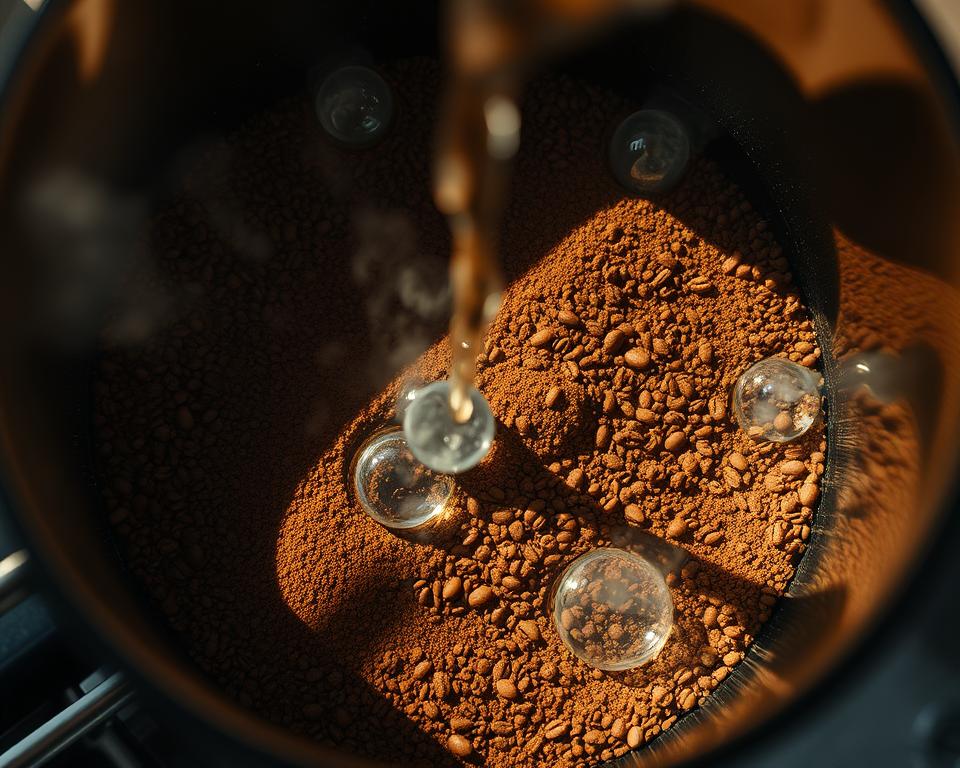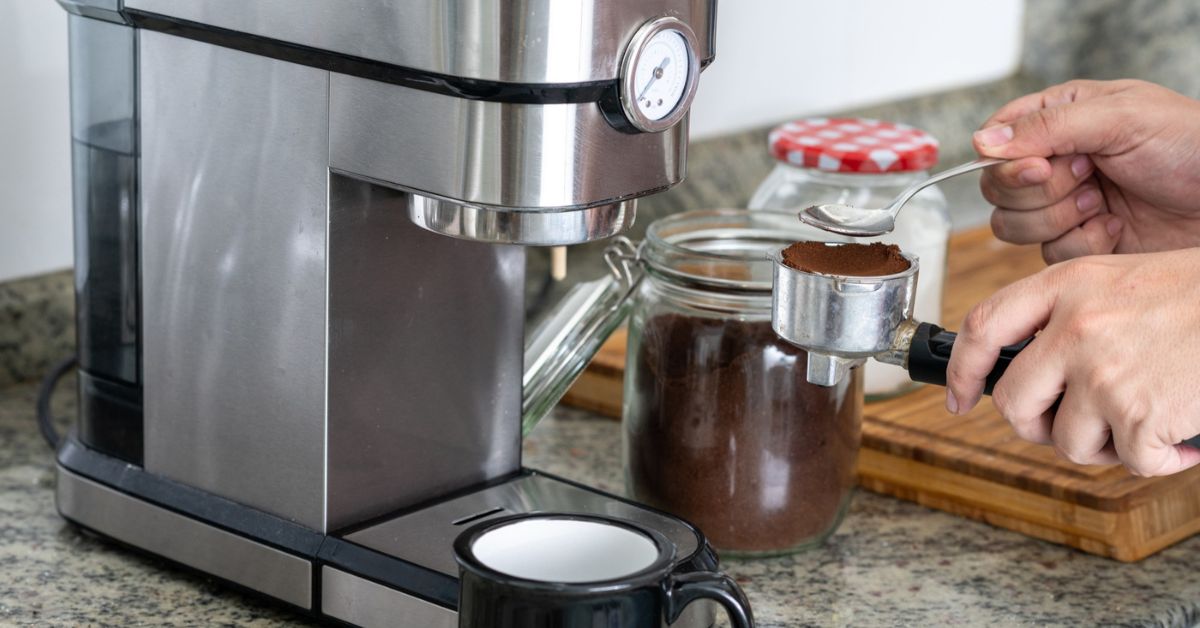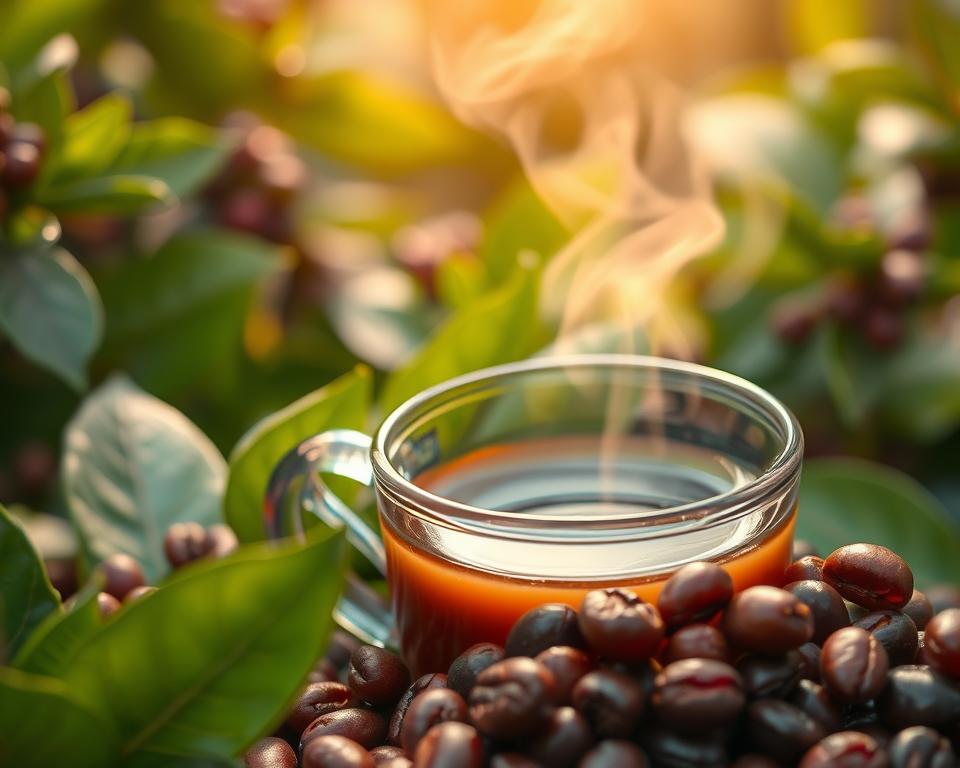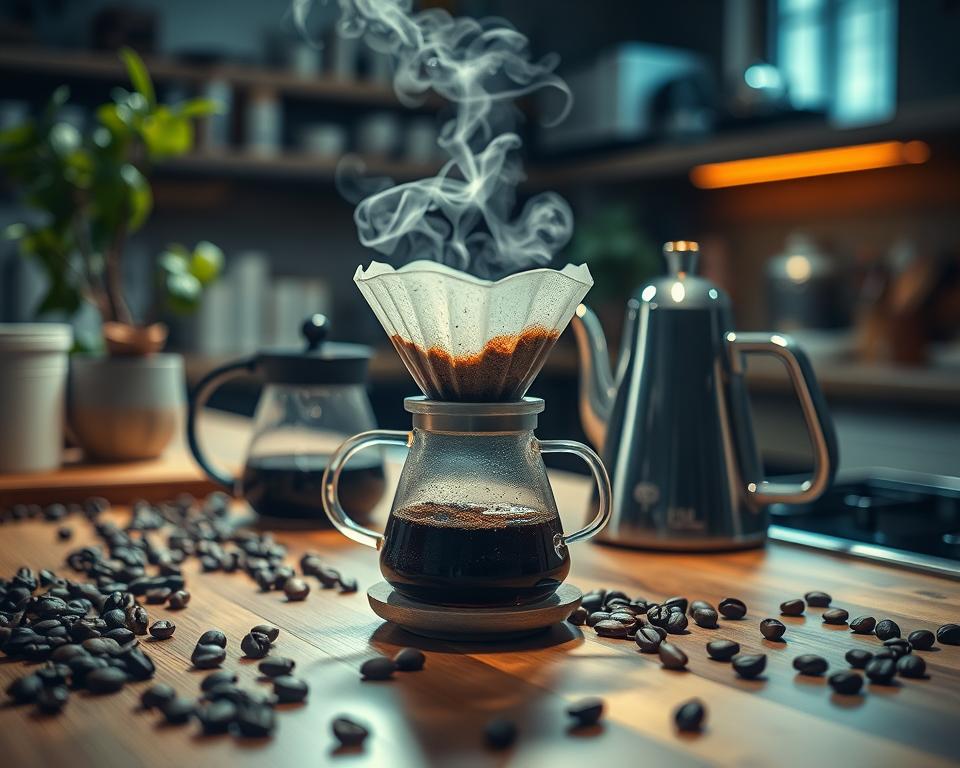Have you noticed how some days your coffee tastes awesome and other days, not so much? That difference may come from the coffee bloom. Starting with fresh beans is the first step to better flavor. Blooming happens when hot water meets coffee grounds, making carbon dioxide escape. This is key for getting a rich taste.
Fresh beans will show a good bloom, which you can see for about 30 seconds. This bloom lets out smells and flavors that make your coffee smell amazing. Using water between 195-205°F makes this process even better. It helps get rid of CO2 faster, which makes the bloom better. So no matter how you make your coffee, remember the bloom is important.
Getting the bloom right means your coffee will taste more even and full of flavor. It keeps the bean’s rich tastes, making your coffee go from okay to amazing. If you love coffee, don’t skip the bloom. It’s essential for bringing out the best in your beans.
What Is Coffee Bloom?
The coffee bloom is a magical moment when hot water first meets your freshly ground coffee. Grounds swell, bubble, and release trapped gases. This is most noticeable with pour-over, French press, and Aeropress methods, making brewing a delight to see and smell.
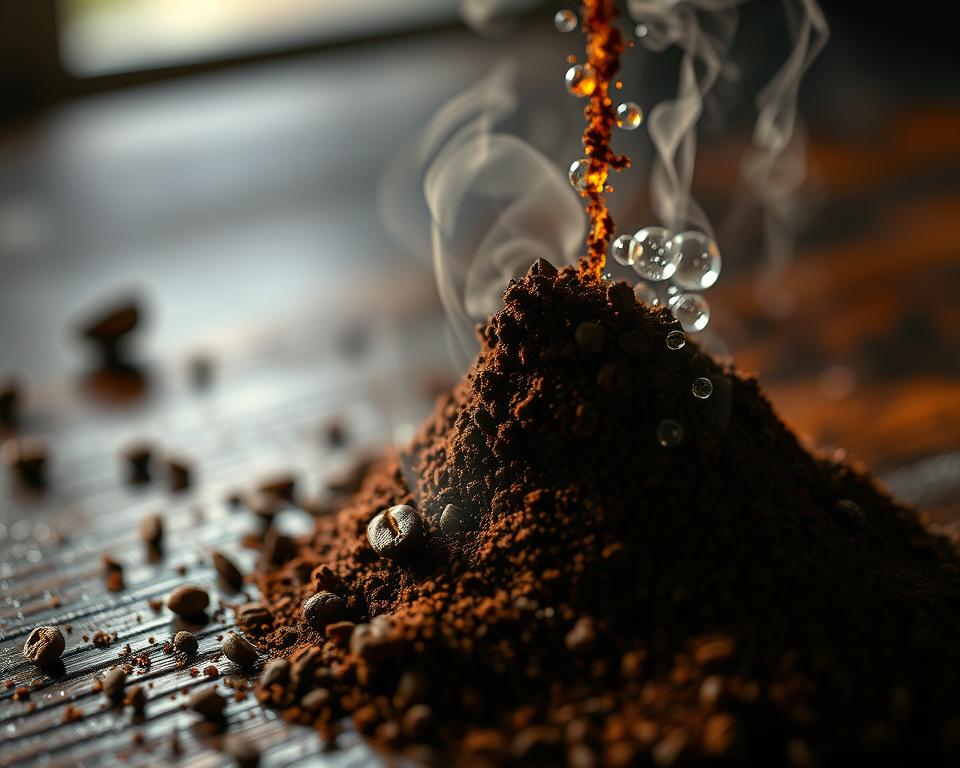
The Science Behind Coffee Blooming
The science of coffee blooming starts with carbon dioxide rapidly escaping from the grounds. This happens when hot water hits freshly ground coffee, known as degassing. Fresh beans have lots of CO2 that gets out fast during the bloom, within 30-45 seconds. This CO2 release makes water mix better with the coffee, leading to uniform extraction.
For the best bloom, use beans roasted no more than two weeks ago. The ideal water temperature for blooming is about 205°F.
The Visual Appeal of a Coffee Bloom
Watching the coffee bloom is truly captivating. With pour-over, grounds puff up, releasing aromatic compounds of a fresh brew. A strong bloom means the coffee is fresh. A weak bloom might suggest it’s older.
Grind your coffee just before brewing for a vibrant bloom. For pour-over, grind three minutes before. For French press, five minutes, and for espresso, one minute. This keeps the coffee’s visual appeal, flavor, and aroma at their best.
The Coffee Bloom Process
The coffee bloom method is key for pulling the best taste from your coffee. This perfect bloom needs steps that focus on fresh grounds, right measuring, and grinding well for freshness.
Measuring Fresh Coffee Grounds
Measuring your coffee right is crucial for a good bloom. Coffee that’s been roasted and ground can soak up twice its weight in water. Brands like Breville, JURA, and Nespresso have great fresh coffee. You should use 2.5 to 3 grams of water for each gram of coffee to get the bloom right. For example, a 1:2 ratio, which means 20g of coffee to 40g of water, is often suggested.
Proper Grinding Techniques
Grinding your coffee right before you brew it keeps it fresh. This helps avoid losing flavor too soon. If you’re making pour-over coffee, use the grounds within three minutes of grinding. Your grind size needs to fit your brewing method. Use finer grinds for espresso and coarser ones for French presses. This matters for how well your coffee extracts.
Adding the Right Amount of Hot Water
It’s important to add the correct amount of hot water for blooming. Double the coffee grounds’ weight and heat your water to about 205°F. Pour slowly, at around 9-10 ml per second, to ensure every ground gets wet. A kettle that lets you control the temperature can help you pour just right.
Timing and Waiting for the Bloom
When you’re blooming coffee, timing matters a lot. Fresh coffee usually blooms for 30-40 seconds. After pouring hot water, wait 30-45 seconds. This lets the water saturate the grounds well and pulls out the best flavor. It also stops uneven extraction and channeling. This way, you end up with a balanced and tasty coffee.
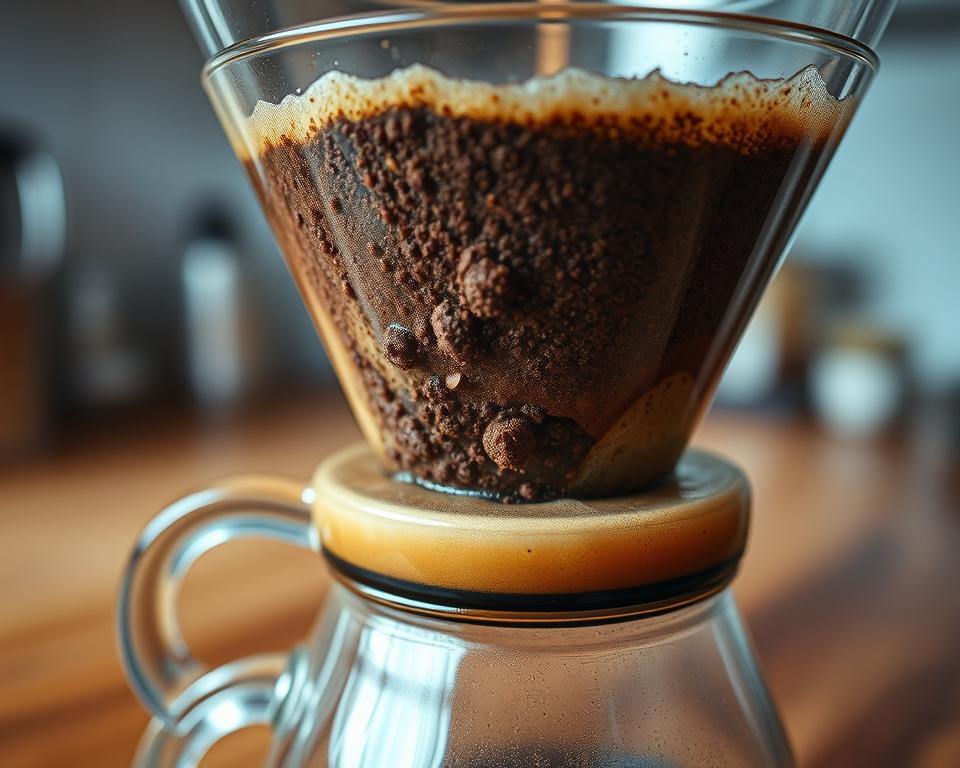
Why Coffee Bloom Matters for a Perfect Brew
The bloom stage is crucial in coffee brewing. It determines the taste, quality, and your coffee enjoyment. When water meets the ground beans, carbon dioxide is released. This step is vital for a balanced and flavorful coffee.
Blooming coffee has big pluses. It lets gases escape and water soak the coffee grounds evenly. This helps get a consistent flavor, especially in light roasts, which bloom more due to their inner gas.
Water temperature is another important factor. Keeping it between 195-205°F makes the bloom better, preventing too early gas release. A good burr grinder gives you an even grind, keeping gases needed for blooming.
The size of your coffee grind affects the bloom too. Fine grinds let gas out fast, but coarse grinds slow the process. Blooming times change with brewing methods. Pour-over needs 30-45 seconds with a stir, while French Press takes about 20 seconds.
Fresh beans bloom best, showing how crucial proper storage is. Moisture can stale coffee, harming the bloom quality. So, getting the timing, grind consistency, and storage right is key to great coffee.
Coffee Bloom Importance in Brewing
Understanding the coffee bloom’s importance is key for great brewing. It’s more than just a step; it’s vital for a lively coffee. The bloom releases trapped CO2, leading to balanced, flavorful coffee.
Proper storage in special bags lets CO2 escape and keeps the coffee fresh. Freshness is crucial for a good coffee bloom. You can use a freshness indicator to check your beans.
Water temperature is critical for the coffee bloom. It should be between 195°F and 205°F. This ensures the coffee is not too bitter or weak. I start with a water ratio of 1:15 for a consistent flavor.
The coffee bloom shows its effectiveness in 30-40 seconds with fresh beans. Grounds expand during this time. Baristas say to bloom for at least 25 seconds, even if the coffee doesn’t bloom much.
Little changes can make a big difference in brewing. Use a digital scale and a timer for precision. Pouring correctly, starting from the center, ensures even extraction.
Experimenting can refine your brewing. Stir the bloom or alter water-coffee ratios. Some coffee brewers offer a “prewet percentage” to control the bloom better.
By focusing on these tips, the bloom can improve the aroma of your coffee. Right water temperatures and proper storage are key. These elements make each cup its best.
Using these methods can uplift your brewing ritual. For more on coffee, check out this link about honey-processed coffee exploring the sweetness to learn more.
Maximizing Flavor and Aroma through Blooming
Brewing the perfect cup of coffee is an art that involves many steps. One important step is the coffee bloom. This process unlocks the full flavor of the beans.
Uniform Extraction
To get the best taste, it’s essential to extract the coffee uniformly. Proper blooming lets water evenly wet the coffee grounds. This ensures the coffee’s oils and flavors dissolve well.
As a result, you get a cup with balanced flavors and rich aroma. Pour-over coffee methods depend on this for a perfect brew every time.
Enhancing Aromatic Compounds
The bloom stage is crucial for releasing CO2. This release amps up the coffee’s aroma. Imagine the wonderful smell spreading in the air as the coffee blooms.
Using light roasts or beans that were roasted recently can enhance this aroma. These beans keep more gas, which boosts the aroma during blooming.
Indicators of Coffee Freshness
The bloom phase tells you a lot about the coffee’s freshness. Beans that are two to four weeks post-roast should bloom vigorously. This vigorous bloom means the coffee is very fresh.
It leads to a rich and complex flavored cup. Trying the Cafe Breve Recipe is a great way to see fresh coffee bloom in action.
Conclusion
Mastering the art of coffee bloom can really change your coffee game. It lets every coffee lover unlock a world of flavors and smells. By getting the hang of blooming, from watching the CO2 bubbles to timing it right, making the perfect cup becomes possible.
Trying out different blooming methods, like single or double blooming, can fine-tune your coffee’s taste. The ratio of water to coffee, usually 1:3 in blooming, is key for flavor. Also, playing with bloom times, like 30 seconds, can make your brew match your taste. Using these expert techniques improves your coffee, bringing out hidden flavors in each pour-over.
To master coffee bloom, pay attention to the grind size, how much water you use, and your brewer’s design. Every step, from choosing fresh beans to the last pour, makes your coffee experience better. Next time you brew, take time to enjoy the bloom. Remember, with the right technique and patience, you can make a cup of coffee that delights the senses and enhances your coffee ritual.
FAQ
What is coffee bloom?
Coffee bloom happens in the first step of brewing. Hot water meets freshly ground coffee, causing it to swell and bubble. This shows the coffee is fresh and starting to give off flavor.
Why does the coffee bloom matter?
The bloom is crucial for a tasty cup of coffee. It ensures the grounds are evenly soaked and gases escape properly. This makes the brew more flavorful and shows the beans are fresh.
How does coffee freshness affect the bloom?
Fresh beans have more trapped gas, leading to a bigger bloom. This makes the coffee taste better. Stale beans result in a weak bloom and less flavorful coffee.
What are the best methods for achieving a good coffee bloom?
For a great bloom, use a pour-over, French press, or Aeropress. They let you control water flow and bloom time. This is key for the best flavor.
How should I measure and grind my coffee for optimal bloom?
Use freshly roasted beans from top brands. Grind them right before brewing. A medium to coarse grind works best for a good bloom.
What water temperature is ideal for blooming coffee?
The best temperature for blooming coffee is about 205°F. A temperature-controlled kettle can help keep this precise. It starts the bloom without burning the coffee.
How long should I wait for the coffee to bloom?
Wait 30-45 seconds after adding hot water for the bloom. This time is important for letting gas escape and setting up the grounds for even flavor.
How does coffee bloom affect the final flavor profile of the coffee?
A good bloom helps everything mix well and gases to escape right. It brings out the best flavors and aromas. This makes the coffee balanced and delightful.
Can I tell the quality of my coffee beans through the bloom?
Yes, the bloom shows bean quality and freshness. A strong bloom means fresh beans and good brewing. A weak one might show stale beans or wrong brewing.
What tips do you have for mastering coffee bloom?
Use fresh beans and grind them just before brewing. Measure carefully, pour water at the right temperature, and follow the bloom time. Doing these will help you get a perfect bloom every time.

